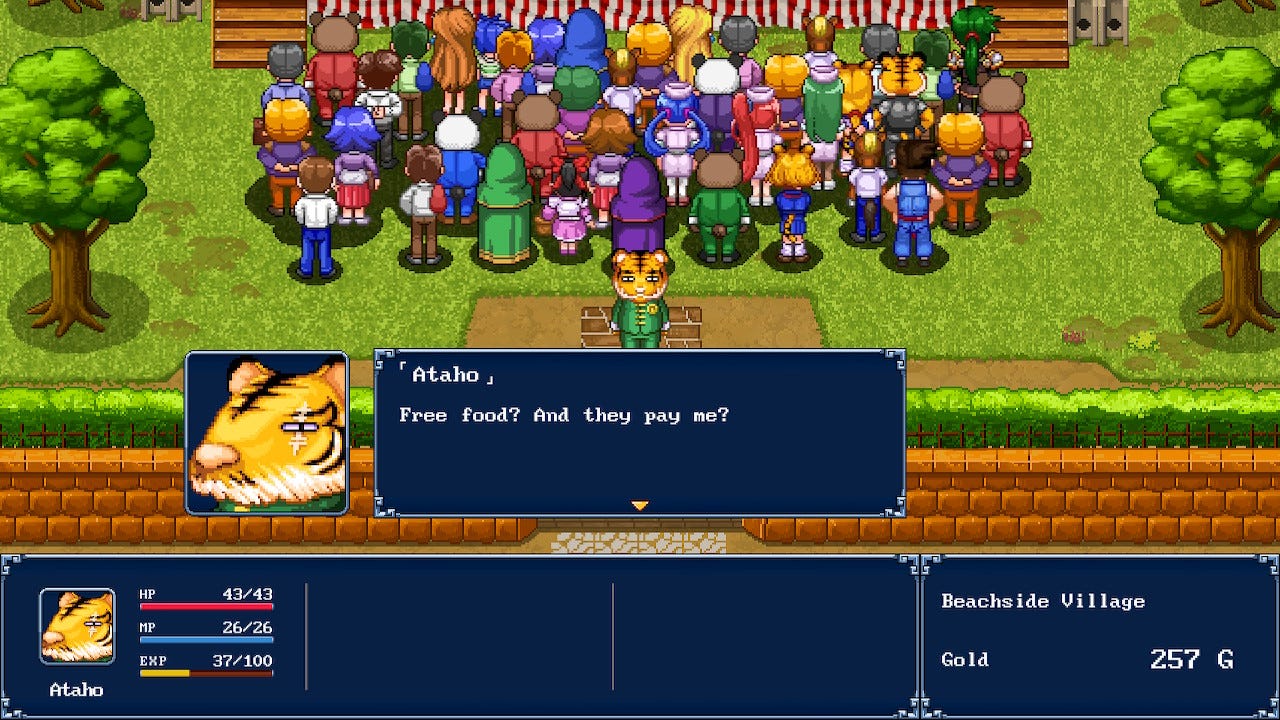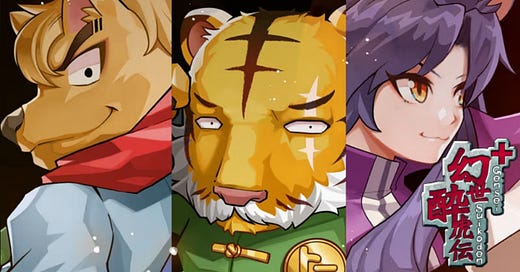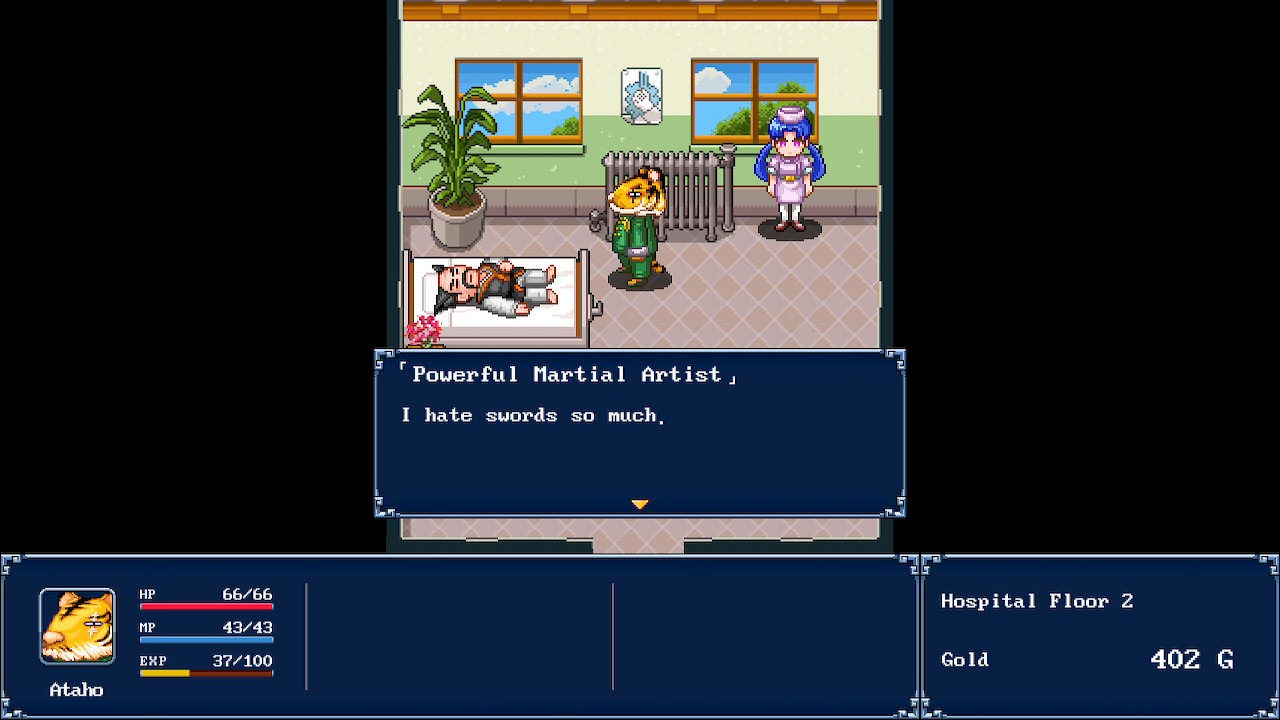Past meets present: Gensei Suikoden
No, not that Suikoden. A different one. Like, really different.
This column is “Past meets present,” the aim of which is to look back at game franchises and games that are in the news and topical again thanks to a sequel, a remaster, a re-release, and so on. Previous entries in this series can be found through this link.
You probably know Suikoden, or at least know of Suikoden. But as the subhed above says, Suikoden isn’t what Gensei Suikoden is, even if there’s an implication there. Gensei Suikoden is the name of a game from an established series of role-playing games, Gensei Kitan, whose developers decided that a pun on Suikoden would be a fun thing to do with a game’s name and not at all confusing. Gensei Suikoden takes place in a Chinese-ish-inspired realm of martial arts RPG battles, and the Suikoden games (and name) were taken from a Chinese novel, Water Margin, which is “Suikoden” in Japanese. Per the series Wikipedia page, the Hepburn translation of Suikoden reads as “Gensō Suikoden,” with a literal translation into English of “Fantasy Water Margin”. So yeah, you can see why they went there in a post-Suikoden world.
The “they” cited above, by the way, were Compile: the Gensei Kitan games, Gensei Suikoden included, were primarily Disc Station releases for various home computers in the 1990s. Gensei Suikoden isn’t the first of these RPGs in the series — it’s actually the sixth of eight, released in 1997 for Windows 95 three years after the initial PC-9801 series release — but it’s the one that was recently given a worldwide release for the first time, in the form of Gensei Suikoden Plus. A little odd, given that the games are connected, with recurring characters and ongoing relationships, but Gensei Suikoden is also a fine game that doesn’t require prior knowledge of the previous games, so if you were going to pick one out of the lineup to introduce it abroad, well, maybe it’s not so odd that this was the choice.
Compile shuttered in 2003 — you might have heard something about that before — and much of the rights to their work were sold to D4 Enterprises shortly after. Gensei Kitan games were part of this sale, so when you combine D4 always looking for ways to make something off their investment into Compile’s library with the popularity of the Gensei Kitan games in South Korea — pretty much the only other place the Disc Station games made their way to — then it’s no surprise that, for as little-known as these games are worldwide, they’d eventually end up with a re-release. And that re-release came by way of publisher Daewon Media, which is based in South Korea, with development handled by a studio, Waycoder, that’s also located in South Korea. Basically, the only real surprise here is that the 2023 Nintendo Switch re-release was a worldwide one, but given the prevalence of digital publishing and distribution in this day and age, maybe we shouldn’t be shocked on that note, either.
The Gensei Kitan games star a sword-wielding dog named Smash, but in Gensei Suikoden, the protagonist is actually a tiger named Ataho who is a practioner of — wait for it — Tiger Style martial arts. He hails from a village of tigers where this martial art originated, and, after a brief intro that implies what you’ll be up against, the game opens with him living up in the mountains, protecting important relics related to his people and their history. He’s capable of handling himself in a fight still, but his skills have, at the least, plateaued living up in the mountains alone, and at worst, have actually atrophied. So you’ll be working him back into fighting shape, as it were, as he remembers old skills and learns new ones. Ataho will eventually partner with Smash, as well as series newcomer, claw-wielding cat girl Rin Shang, and the three of you will attempt to (A) make it to the annual martial arts tournament taking place in the tiger village, then (B) solve the riddle of where the heck those dark powers that made themselves known at the tournament came from.
Much of the game is a tutorial on how the battle system works, but it’s not the slog that sentence implies: there’s a deep battle system here, but it’s also a fast-paced one, so the “tutorial” is more the game showing you the various ways the battle system works, why you might want to use one kind of stance or skill over another in a given situation, and then the back-end of the game requires that you took something from those lessons.
Battles are random and turn-based, but again, everything is fast-paced, so even if that’s not your preference for an RPG, you’re not going to feel as if there’s a lack of dynamism here. (As a bonus: in the Plus version of the game, you can set battles to 2x speed, as well, with a simple button press toggle at any time.) The depth is clear from the outset: Ataho begins with four different standard attacks that work in different ways, none of which use MP to deploy. The Throw, for example, is useful against enemies in a Defend stance — more on that in a second — while something like the Roundhouse Kick is a high-powered attack, but with a lower hit rate than the even more standard Straight Jab, so it’s a real risk-reward scenario every time to attempt one.
You have different “Battle Modes” to choose from: Offensive, Defend, Preemptive, Counter, and Normal. Each of these will make your own actions work differently or have different effectiveness. If your mode is Defend, for instance, that doesn’t mean you’re defending for that round and not attacking. It means your defense will be higher for that turn, but at the expense of delivering a strong attack. Similarly, if you decide to go all out with Offensive, your attack will go up, but you’ll leave yourself exposed on the defensive side. There are times whether each approach makes sense, like with a boss that hits real hard that you need to outlast to defeat because you won’t win a battle of straight power vs. power. You might be tempted to kill them as fast as possible with strong attacks, but you won’t: the proper approach is to go defensive, then slowly whittle down their health bar while healing.
Preemptive will let you attack sooner in the turn order, which can be good for quick enemies, and Counter has you react to enemy attacks instead of trying to go sooner. Normal is just the base stats, which can work a fair amount of the time, but as the game goes on you’ll want to focus on the contextual specializations. What makes them compelling, too, is that these battle modes aren’t party-based, but character-based: if you want to set Rin Shang to spend her time healing, set her to Defend. If you want to go all-out with focused special attacks with Smash and don’t care about the potential damage he’ll take because the tradeoff is worth it, set him to Offensive. Or, bump up his speed with Preemptive so he’s always attacking first. And you can switch the mode at any time, too, so you’re not locked in for a battle or whatever: it’s a button press to cycle through the list every turn if you want to adjust on the fly to account for the changing conditions of battle, or a strategy that’s not working for you, and so on.
On top of this, there are also elemental considerations in your attacks. Certain elements are less effective or more effective against the other elements in something of a four-way rock-paper-scissors arrangement: your characters have some elemental weaponry and also elemental special attacks, so, using the proper element in the proper situation will go a long way. Combine the elemental exploitation with utilizing optimal battle modes, and baby, you’ve got a martial arts RPG going. And that’s without even mentioning that a central plotline of Gensei Suikoden involves Ataho learning the Drunken Master martial arts style, which yes, means you have an entirely different set of skills to deploy when you get Ataho drunk mid-battle. Not too drunk, though, or else things won’t go how you hoped. Booze is a consumable resource like any other, as well, so you can’t just always be plastered, but have to balance determining the best time for these attacks with the need to utilize them to hone your (drunken) skills.
You gain experience from defeated enemies, and in something of a fun twist for a turn-based RPG, that experienced is gained as each enemy is defeated, not at the end of battle. Which means if you time things right, you can actually gain a level mid-battle and replenish both your health and MP — that might even turn a lengthy encounter with a boss in your favor!
This might be an RPG from 1997, but it was made with being a breeze in mind instead of as this growing, ever-expanding thing like Playstation RPGs of the day. Not to be easy, no, but to be something you can pick up and get through in short order, and feel like it didn’t take forever, too, while still delivering something with some meat on it.
The battle system is described as “brisk” in the game’s description, and it is even if you don’t crank the battle speed up to 2x. The story pacing is also great, which makes sense: a Disc Station game could only be so big if Compile was going to fit multiple titles in one “magazine” along with the digital anime shorts and other goodies stored on there. Everything is broken down by chapter, and travel is often in-location, with longer distances traversed automatically. There’s no larger map, basically, just areas within a map you can’t see, and you travel within the areas themselves. You’ll be warned when you’re about to hit the point of no return that’ll cut you off from backtracking, and otherwise, your warnings about being somewhere you’re not supposed to be yet are either a little joke of dialogue, or enemies that will crush you in seconds. Luckily, if it’s the latter, there’s no lost progress for dying. You just get sent back location wise while retaining experience, levels, etc., and try again or realize, “oh, not yet.”
It does leave quite a bit up to you within these areas, though, so you’ll find yourself where you aren’t “supposed” to be sometimes. Big picture stuff, yeah, Gensei Suikoden outlines what’s needed from you, but the little stuff? Go explore that abandoned ruin or that cave, sure. You’ll likely find something in there you didn’t know you were looking for, or some additional quest or power. Which does matter in the end, as you’re graded — given a Martial Artist Rank — after the adventure is over based on how much of the game you actually managed to see or experience. You can’t unlock all of the finishing move special skills without actually exploring the entirety of your arsenal — skills level up the more you use them, which cuts down on MP cost, but also leads you to additional skills — and you won’t get to the secret actual final boss without having a knowledge of the game and its potential routes, either. After completing a run, you do have the option of hearing where all the secret stuff is so you can go back and try to find it on an additional replay, but you can also go in without that knowledge and try to discover it all from the ground up yourself, instead.

Replaying isn’t a chore, either, as you can spend fewer than 10 hours playing Gensei Suikoden even if you don’t know what you’re doing. It’s designed to be replayed, for you to find all the secrets and encounters and jokes, and, eventually, to defeat the secret actual final boss that’ll get you the true ending and allow you to put Gensei Suikoden (Plus) to bed. Given how much personality exists in the game, replaying does sound like an intriguing prospect.
To rewind to the beginning for a second, this is a game that made its title into a confusing pun just because it’d be funny. You’ll see visual gags everywhere, like famous martial artists very much in the Similar To But Legally Distinct From realm such as Street Fighter’s Ryu or Tekken’s Heihachi Mishima. Smash is a bit of a pervert whose most prized possession is a girly magazine, and he also thinks a clean bathroom is basically the greatest thing in the world. It breaks the fourth wall on occasion, such as when Ataho says to the player, “If you leave here, you won’t be able to come back, so choose wisely!” only for Smash to respond with, “…Who are you talking to?” It’s a strange game, but said in a complimentary way, so why would you not want to see all it has to offer, especially when the runtime is so short for an RPG?
It’s a Compile game, so there’s a ton of attention to detail in the sprites, which are large, and the soundtrack, while a bit short, is also great. It’s easy to see why the Disc Station games were such a priority for Compile in their later years, and why they were able to be a priority, when you see something like Gensei Suikoden: it’s not like Compile just made quicker and “easier” to develop games to get them out there, but instead made clearly thoughtful experiences that they just didn’t want to rely on the retail model of the day for. Gensei Suikoden has so much in common with the kind of digital-only RPGs made by indie creators you’d find on Steam or somewhere in the Switch or Playstation storefronts, and it got there what, 20-plus years before the kind of game you know I’m referring to became A Thing? Compile in a nutshell, really.
The good news — well, not for Compile, which is (mostly) no more — is that there’s still an opportunity to take advantage of the distribution systems of today to get these smaller, pre-digital RPGs of the 90s out there to a larger audience that could be ready to experience them. Gensei Suikoden is a charming little game with a goofball personality and deep battle mechanics. It’s replayable, it looks great, it sounds great, and most importantly, it has me wanting to experience the rest of the series. If enough people who play this feel similarly, maybe we’ll all get the chance for that.
This newsletter is free for anyone to read, but if you’d like to support my ability to continue writing, you can become a Patreon supporter, or donate to my Ko-fi to fund future game coverage at Retro XP.







This sounds fun, and still unique. Always cool to learn about a game like that.